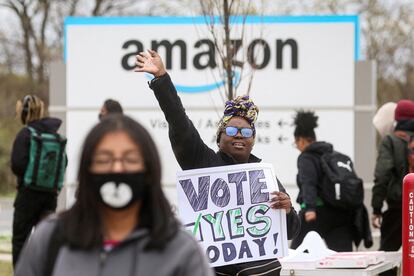US elections will gauge support for unionization in two states
Illinois and Tennessee voters face radically different choices when it comes to worker rights


The most significant drive for labor unionization in the United States since the early 1970s will be put to the test in the upcoming midterm elections. Voters in Illinois and Tennessee are being asked to decide on two antithetical visions of the future of organized labor: the right to collective bargaining versus the right to work. The latter allows individual workers to choose whether or not to join a union, and frees non-members from paying compulsory union dues. Illinois wants to do away with right-to-work laws while Tennessee wants to amend its state constitution to include right-to-work provisions like nine other states. Across the US, 27 states have enacted various right-to-work laws, evidence that the country’s divisive polarization extends to labor relations.
In the US, workplaces not individuals get to decide whether to unionize. Recently, workers at large corporations, small businesses, restaurants, architectural firms and local newspapers have held votes on unionization. They represent a groundswell that may develop into a tidal wave, or may crash upon the rocks of an economic downturn or an electoral rejection. While labor unions historically found their greatest support in heavy industry, they are now seeking a foothold in the fragmented service sector. The Starbucks coffeehouse chain’s first union was formed in a Buffalo (New York) store last December, and now more than 8,000 Starbucks stores across the country must individually decide whether to unionize. Although a hundred or so Starbucks stores followed in Buffalo’s footsteps, a successful vote to unionize is by no means a foregone conclusion. Starbucks associates in a Chelsea (New York City) store reported receiving threats from company management when they began to talk about organizing.
Ever since employees at an Apple store in midtown Manhattan filed for unionization in the spring, they have refused to speak out for fear of reprisals. “The walls have ears here. Talking to reporters is not encouraged… it would be detrimental to our cause. Speaking publicly about the unions would not be good for anyone – quite the contrary,” an Apple worker told EL PAÍS. Promises of anonymity and the successful unionization effort of Apple workers in Towson (Maryland) did nothing to persuade him to speak to us. Small victories frequently collide against everyday problems, resulting in an uncertain future for the labor movement. After the historic victory in April at Amazon’s Staten Island distribution facility, workers at the country’s largest private employer voted against unionizing in an Albany (New York) logistics center, the second such setback in recent months. According to the MarketPlace.org business and economic news site, smaller workplaces have enjoyed more unionization success in 2002.
The measures facing voters in Illinois and Tennessee represent two opposing views of the surging unionization efforts that have grown by 60% in the service sector over the last six months. The Illinois referendum proposes enshrining collective bargaining rights in the state constitution, as New York, Hawaii and Missouri have done. Although Illinois has had right-to-work laws since 1947, this will be the first opportunity for voters to formalize them in their constitution.
Only 5.9% of Tennessee workers are union members, significantly lower than Illinois (13.9%) and the national average (10.3%). Tennesseans will have the opportunity to cement a right-to-work law into the state constitution at the ballot box in November, a move touted by pro-business leaders but adamantly opposed by organized labor unions. The proposed constitutional amendment is a reaction to the disingenuously named Protecting the Right to Organize Act (PRO Act) bill passed in the US House of Representatives in the spring of 2021. This federal labor reform bill, the most ambitious since Franklin D. Roosevelt’s administration, would prohibit state-enacted right-to-work laws as well as the permanent replacement – another euphemism – of striking workers.
“Right-to-work policies are designed to erode worker rights. Its proponents claim that they protect workers from being forced to join unions, but their real purpose is to tilt the balance in favor of big corporations and further rig the system at the expense of working families,” says the American Federation of Labor and Congress of Industrial Organizations (AFL-CIO), the largest federation of labor unions in the United States.
In a recent interview, University of Chicago professor Gabriel Winant said the current unionization efforts reflect “a shifting balance of power in labor markets, with workers gaining more influence during the post-pandemic recovery. But so few workers are unionized that much of this discontent continues to be channeled individually rather than collectively.”
A massive unionization surge in the US would be momentous in a country that reached its lowest level of union membership ever in 2021, when 30 states and the District of Columbia were below the membership national average. Just over 14 million workers were union members last year in a country of 332 million people. “US labor laws are heavily biased against union elections, as was clearly demonstrated by the effort of Amazon workers in Alabama,” said Jack Rasmus, a former union organizer who is now a professor of economics at Saint Mary’s College of California. In April 2021, Amazon workers in Bessemer, Alabama overwhelmingly rejected forming a union. The National Labor Relations Board (NLRB), the independent federal agency that oversees worker rights, forced a re-vote after finding evidence of pressure and irregularities by company management. “Law firms specializing in anti-union litigation are a multimillion dollar business that has been thwarting unionization for decades,” said Rasmus.
The NLRB is facing its own challenges. The NLRB’s own union recently tweeted, “The National Labor Relations Board — the sole federal agency tasked with enforcing private-sector employees’ rights to organize and collectively bargain — is in a crisis. After years of inattention by Congress, the agency no longer has the resources to adequately enforce its mission.” The NLRB has not received an increase to its budget from Congress since 2014, and inflation means flat funding is essentially a budget cut, said the union in another tweet.
The winds are also shifting among Democrats, despite having the most pro-union president in decades in the White House. A poll earlier this year found that as many as 69% of Virginia Democrats believe that public sector workers should “have the right to quit unions and stop paying union dues.” Meanwhile, support for right-to-work laws is as high as 91% among Virginia Republicans, and 90% among independents. Most southern states have right-to-work laws in place.
Back in 2017 when Donald Trump was in the White House, Republicans introduced a right-to-work bill in the House of Representatives. Earlier attempts at passing similar federal laws have failed since the 1940s, despite several recessions and major economic crises in the 1970s and 2008. As such, individual states have been left to their own devices when it comes to regulating this central aspect of democracy – should majority opinion prevail over minority rights, or is it every man for himself in the USA?
Tu suscripción se está usando en otro dispositivo
¿Quieres añadir otro usuario a tu suscripción?
Si continúas leyendo en este dispositivo, no se podrá leer en el otro.
FlechaTu suscripción se está usando en otro dispositivo y solo puedes acceder a EL PAÍS desde un dispositivo a la vez.
Si quieres compartir tu cuenta, cambia tu suscripción a la modalidad Premium, así podrás añadir otro usuario. Cada uno accederá con su propia cuenta de email, lo que os permitirá personalizar vuestra experiencia en EL PAÍS.
¿Tienes una suscripción de empresa? Accede aquí para contratar más cuentas.
En el caso de no saber quién está usando tu cuenta, te recomendamos cambiar tu contraseña aquí.
Si decides continuar compartiendo tu cuenta, este mensaje se mostrará en tu dispositivo y en el de la otra persona que está usando tu cuenta de forma indefinida, afectando a tu experiencia de lectura. Puedes consultar aquí los términos y condiciones de la suscripción digital.
More information
Archived In
Últimas noticias
From Andorra to Gibraltar, a black market for Ozempic exploits its success: ‘They’re the most sought-after products in the world’
Magnets in their heads: How some animals guide themselves using the Earth’s magnetic field
From Hungary’s Orbán to Chile’s Kast: How Trump helps turbo charge the far right
The brief rise and retreat of Generation Z in Mexico
Most viewed
- Why we lost the habit of sleeping in two segments and how that changed our sense of time
- Charles Dubouloz, mountaineering star, retires at 36 with a farewell tour inspired by Walter Bonatti
- Venezuela faces its most tense Christmas yet
- CBS in crisis after pulling a report on Trump’s deportations to El Salvador (which later leaked online)
- Bukele clan fumes over investigation exposing their new wealth










































